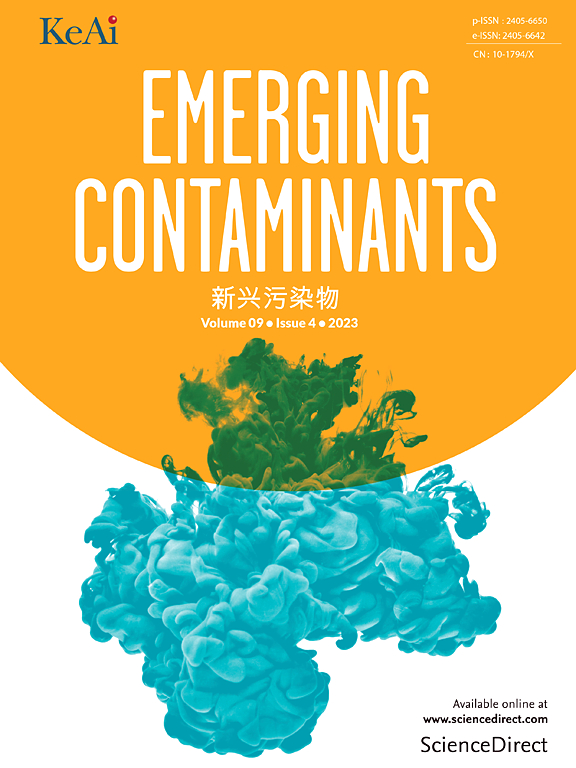Environmental behavior of microplastic - heavy metal synergistic contamination in a typical urban-rural river network
IF 6.9
2区 环境科学与生态学
Q1 ENVIRONMENTAL SCIENCES
引用次数: 0
Abstract
Microplastics (MPs) and heavy metals (HMs) in rivers pose a global threat to human health and the ecological environment. Given the differences in pollutant classes, the co-occurrence and interactions between MPs and HMs are still poorly understood. In this study, the co-occurrence of MPs and HMs across different seasons were investigated in the urban-rural rivers of a typical inland city, China. MPs and HMs were detected in all water samples at the wet and dry seasons, and the differences in the abundance of MPs and HMs between the two water periods were not significant. The abundance of MPs was higher in urban and industrial zones than that in agricultural zones. The predominant form and composition of MPs was granules (44.49 %) and polyethylene terephthalate (PET, 85.40 %), with the most common color being transparent (48.99 %). HMs (Mn, Cu, Cr, Zn, Cd, Pb) were detected in MPs, with the strongest adsorption capacity observed for Mn (Kpw = 4.90). Based on the correlation analysis and structural equation model, the polymer type of MPs (path coefficient = 0.3798) and the content of HMs in water (path coefficient = 0.3391) were the significant influence drivers on the adsorption of HMs by MPs. The Hazard Index revealed a medium risk of MPs in the urban-rural rivers, while the Pollution Load Index indicated a low risk of the river water body. These findings suggest that synergistic pollution from MPs and HMs may increase the ecological risk in river water, and the results provide important data for understanding the characteristics of the urban-rural rivers.

典型城乡河网中微塑料-重金属协同污染的环境行为
河流中的微塑料(MPs)和重金属(HMs)对人类健康和生态环境构成全球性威胁。鉴于污染物类别的差异,MPs和HMs之间的共同发生和相互作用仍然知之甚少。本研究以中国典型内陆城市城乡河流为研究对象,研究了不同季节MPs和HMs的共现情况。所有水样在干湿季节均检测到MPs和HMs,两个水期MPs和HMs丰度差异不显著。城市和工业区的MPs丰度高于农业区。MPs的主要形态和组成为颗粒(44.49%)和聚对苯二甲酸乙二醇酯(PET)(85.40%),最常见的颜色为透明(48.99%)。MPs对Mn、Cu、Cr、Zn、Cd、Pb的吸附能力最强(Kpw = 4.90)。基于相关分析和结构方程模型,MPs的聚合物类型(通径系数= 0.3798)和水中HMs的含量(通径系数= 0.3391)是MPs吸附HMs的显著影响因素。危害指数显示城乡河流污染风险中等,污染负荷指数显示河流水体污染风险较低。研究结果表明,城乡结合部河流的协同污染可能会增加河流的生态风险,为了解城乡结合部河流的特征提供了重要的数据依据。
本文章由计算机程序翻译,如有差异,请以英文原文为准。
求助全文
约1分钟内获得全文
求助全文
来源期刊

Emerging Contaminants
Medicine-Public Health, Environmental and Occupational Health
CiteScore
10.00
自引率
6.70%
发文量
35
审稿时长
44 days
期刊介绍:
Emerging Contaminants is an outlet for world-leading research addressing problems associated with environmental contamination caused by emerging contaminants and their solutions. Emerging contaminants are defined as chemicals that are not currently (or have been only recently) regulated and about which there exist concerns regarding their impact on human or ecological health. Examples of emerging contaminants include disinfection by-products, pharmaceutical and personal care products, persistent organic chemicals, and mercury etc. as well as their degradation products. We encourage papers addressing science that facilitates greater understanding of the nature, extent, and impacts of the presence of emerging contaminants in the environment; technology that exploits original principles to reduce and control their environmental presence; as well as the development, implementation and efficacy of national and international policies to protect human health and the environment from emerging contaminants.
 求助内容:
求助内容: 应助结果提醒方式:
应助结果提醒方式:


